Related Articles
Copy Editor: Andree Leclerc, Canada
Horoscope is the map of heaven, penned by the Supreme Being in a timeless celestial language. And Jyotish is the name for deciphering the codes of this language.
While decoding this celestial language, the question of when is specifically dealt with by dasa. Literally it means condition or state and technically it connotes the mechanism of interlaced planetary periods. It is akin to the seasons, spanning over the entire life of every individual. For vimshottary dasa – the queen among planetary periods – there are 9 such major seasons, and the good, bad or middling effects of these seasons are hinged upon native’s karma.
Almost all ancient astrological canons thoroughly deal with calculations and results of dasas. Most of the treatises enunciate dasaphala with respect to avastha (Dipt, Swasth, Pramudit, Shanta etc.), bhavesh (lord of the houses) and nakshatra (janma, sampat, vipat etc.). But explaining the computation or reiterating the cognized principles does not serve the due purpose of this article. The aim of the scribe is to divert the attention of readers towards another widely known yet neglected aspect of weighing a dasa. The principle is “treat the dasanatha as lagna”. Well, there would surely be nothing new in this quotation. Every learner of jyotisha assumes dasanatha as lagna when he interprets bhuktiphala by considering the placement of antardasa lord with respect to mahadasa lord. Phaladeepika clearly states this fundamental criterion (vide Adhyaya 20, Sloka 29). So, what’s new in it? But hold on! Before jumping to conclusion, just remind the house analysis chapter of any standard jyotisha treatise and focus the slokas that deal with the relative planetary position from a house. For the sake of ease, some of the pertinent slokas and sutras are given here under.
Guiding on the essentials of house analysis, Mantreshwara writes, “the strength of a house such as the lagna etc. should be adequate and the house sufficiently beneficial if the 1st, 2nd, 4th, 5th, 7th, 9th and 10th from that house are occupied by auspicious planets or the lord of the house is free from the occupation by and aspect of malefics. The house concerned should be considered to deteriorate in its effects if the above houses are not so occupied and aspected. The effects will be mixed if such positions are influenced by occupation or aspect by both benefics and malefics.” (Phaladeepika, XV-2)
Vaidyanatha Dikshita’s Jataka Parijata (a title that has been a jyotish text for centuries in India), teaches: “astrologer should pronounce a house strong and beneficent when kendra and trikona with respect to that house are occupied by natural benefics or the lord of that house.” (Jataka Parijata, XI-6)
Describing the strength and weakness, Kalidasa (besides referring to other conditions) maintains that natural malefics when occupying in the 9th, 4th, 8th, 5th and 12th reckoned from a house, its house lord and respective significator, destroy them. (vide Uttra Kalamrita, IV-12)
Maharishi Jaimini expounded on raja yoga involving special placements of benefic and malefic planets. “Benefics in 2nd, 4th, 5th, 8th and 9th results in Raja Yoga. Malefics in 3rd and 6th give similar results.” (Jaimini Sutram, Adhyaya-I, Pada-III, Sutra 30-31).
However, some commentators have explained this as “when 2nd, 4th and 5th houses from a karaka have an equal number of planets and benefic occupy there, one enjoys raja yoga.” In either case Maharishi Jaimini appears to accentuate the relative strength of 2nd, 4th, 5th and 9th houses. Deciphering the sutra is not the objective of this write-up. Similar planetary signature is also discussed by Maharishi Parashar as an ideal condition like, perhaps, raja yoga (vide BPHS Rajayoga Adhayayah, slokas 9-10).
In the very context of relative planetary positions, Sri Mahadeva expresses, “If the kendras, konas and 2nd house with respect to any bhava are occupied by benefic planets or their respective lords, the growth of the bhava will be the result. If however they be occupied by malefics, the bhava in question will be destroyed. If they be occupied by both malefics and benefics, the result will be mixed.” (Jataka Tatva, Prakeerna Tatva, Sutra-6)
Now change the word “bhava” to “dasanatha” in the aforementioned classical stanzas. And treat the dasanatha as lagna. Scribe got the clue of superimposing this rule over dasanatha from Brahat Parashar Hora Shastra. In the chapter of charaadi dasa adhyaya, Parashar maintains:
“If there are malefics in the randhar (8th house), and trikona (5th and the 9th houses) from a dasa rasi, O’Brahmin! effects of the dasa will be distressful. If there are malefics in the 3rd and the 6th from a dasa rasi, the effects of the dasa will be victory over enemies and happiness. If there are benefics in the 3rd and the 6th from the dasa rasi, there will be defeat in its Dasa.”
(BPHS, Chapter 52, slokas: 4-5)
It is known to all that these BPHS slokas are composed for judging the chara and other rasi dasa effects and not for the udu dasa. In spite of this, an attempt is here made to apply relative house positions’ rules on the vimshottari dasanatha since it provides awesome results on practical ground. In fact, this chapter of Charadhi Dasaphal Adhayah provides mass of information about how to judge a period. Another inspiration of forming this rule is the Nadi literature. Various Nadi discourses primarily gauge strength or weakness of a karakgraha from the condition of relative planetary placement. In this regard, Bhrigu Nandi Nadi accentuates trikona (1st, 9th, 5th) and dwirdwadasa (2nd, 12th) from a significator more than all other factors.
For a clearer picture, a thesis is established hereunder, followed by its explanations and case studies.
Thesis
1) Counting from dasanatha, if there are benefics in konas, kendras and 2nd whereas malefics in 3rd and 6th then dasa produces auspicious results.
2) Counting from dasanatha, if there are malefics in konas, and 2nd, 4th, 8th, whereas benefics in 3rd and 6th then dasa produces evil effects.
Explanation
In the thesis forwarded above, dasanatha is taken analogous to ascendant and the occupation of natural benefic and malefic planets are considered in certain vital houses. These relative houses (from dasanatha) may be grouped into kona, kendra, upachahya and mokshasthana. But on testing this rule, it has come out that natural benefics in 5th-9th, and 2nd-4th specially multiply the fruitful results whereas malefics in these houses multiply the evil effects. Similarly, malefics in 3rd and 6th houses counting from any major or sub period yields favourable results.
The abode called randhar i.e. 8th house from any major or minor period should ideally be vacant. It was found in this study that occupation of (at least two) natural malefic planets in 8th from dasanatha may lead to fall from position, financial crises and humiliation during that dasa or antar. Their desirable placement is upachaya from any dasanatha, especially in 3rd and 6th, where they yield advancement in ventures, commanding position and victory in competitions. Association of two malefics in either 3rd or 6th house or even a single strong malefic in either 3rd or 6th house from dasanatha, helps to accrue authority, provided 2nd and 4th houses are not occupied by other natural malefics.
Exceptionally favourable effects are observed during a vimshottari dasa, where benefics are in 5th-9th and 2nd-4th, and simultaneously malefics are in 3rd-6th with respect to dasanatha, even if dasanatha itself occupies dusthana or owns trishadaaya bhava from janma lagna. Similarly, reverse situation (i.e. when natural malefics seize 5th-9th and 2nd-4th, whereas natural benefics domicile in 3rd-6th from a dasanatha) entails fruitless or perhaps devastating result. In this scenario, a dasanatha may fail to fructify desirable results, even if he is the owner or occupant of favourable house from janma lagna.
For illustrations, besides 8th house, three sets of houses (2nd-4th, 5th-9th and 3rd-6th) are particularly focused.
- a) Axis of 2nd and 4th houses from dasanatha for financial stability and material prosperity during the dasa/antar.
- b) Axis of 5th and 9th houses from dasanatha for opportunities and all around success during the dasa/antar.
- c) Axis of 3rd and 6th houses from dasanatha for victory, new venture and advancement during the dasa/antar.
Aggregate status of the occupation of planets in above mentioned set of houses (excellent, favourable, unfavourable, or admixture of both good and bad) should be deducted intelligently.
For example, suppose a dasa of Venus who is sitting alone in 11th house for Aquarius lagna. First judge the ownership and occupation and standard strength parameters. Apparently looking, yoga karaka Venus in 11th house (i.e. in Sagittarius) is well placed and ought to give promising results. But if there were Ketu and Sun in Capricorn (2nd to Venus), and Rahu and Mars in Cancer (8th to Venus), and Jupiter in Aquarius (3rd to Venus) then Venus dasa would NOT give desired results. In contrast, native may encounter defeat in contest (in elections, competition, interview etc.) and devastating financial setback, despite the fact that these planets do not seemingly constitute any association or aspect to Venus. The reason is the presence of natural malefic planets in 2nd and 8th (from Venus) and a strong benefic (Jupiter) in 3rd from dasanatha Venus. (However, native’s destiny shall not raze to ground, as dasanatha is itself natural and functional benefic).
But for the same case of Venus in 11th house (in Sagittarius); if Mercury occupies in Capricorn, Mars and Sun dwell in Aquarius and Jupiter resides in Leo then Venus dasa would prove quite favourable for material comfort, and opportunities. The rationale behind this verdict is the presence of benefic Mercury in 2nd, malefic Mars with Sun in 3rd and Jupiter in 9th (from dasanatha Venus). This distribution of planets constitutes a worthy map with respect to dasanatha.
Adverted case of Venus is a hypothetical example with raw application of planetary occupation with respect to dasanatha. Coupled with occupation, if reader considers the ownership and strength factors of planets, with respect to dasanatha, then result of any period can be precisely weighted.
Let’s consider another example of Mars dasa for Gemini ascendant. Suppose dasanatha Mars is sitting in 3rd house in Leo with Sun. Here if the principle “treat dasanatha as lagna” applies intelligently, then Mars in Leo with Sun implies, “lord of 9th and 4th in ascendant with ascendant lord”, since Aries and Scorpio are located in 9th and 4th from Leo, where Mars occupies with Sun. In other words, considering functional lordship with respect to the sign where dasanatha occupies. Should such a Mars be devoid of other inimical sambandha (conjunction, aspect etc.) or if Mars does not become the dispositor of other inimical planets, then its dasa would prove auspicious, despite the fact that Mars is generally ranked a first rank malefic for Gemini. Moreover, if the very Mars further enjoys the occupation of natural benefic planets in trine, 2nd or 4th, and natural malefic planets in 3rd and 6th then such a Mars dasa would definitely be excellent.
Exceptions
While scrutinizing mentioned relative planetary positions from dasanatha, it was found that given thesis does not function significantly:
- i) During the dasa of planet involved in Parivartana.
- ii) During the dasa of retrograde planet or nodes when sambandhi with others.
iii) During the dasa of planet closely conjoined with cluster of planets.
Besides these three odd conditions, effect of relative planetary positions from dasnatha shows very significant results.
Illustrations
Case-1: Premiership
This is one of the most exemplified horoscopes in the articles and books of Vedic astrology, with the emphasis on Moon, Mars and Rahu dasas. Native is none but Nehru: the first Prime Minister of India. Let’s begin with the period of Mars (1948-55) in which Jawaharlal Nehru enjoyed the office of prime minister with full pomp and power. In support of such a powerful result, it is usually (and well) argued that Mars is the yoga karaka with respect to janma lagna and chandra lagna, and by sitting in 3rd house it casts full aspect over 10th house. Moreover, Mars as dasamsa lagnesh abodes alone in 10th house of D10. However, it is to be noted that Nehru became prime minister of India during Moon-Venus antaradasa and not in Mars dasa or antar. During the entire Mars mahadasa, his position got strengthened and sustained. Besides enjoying unparallel public support in the Mars period, he shaped the Indian foreign policy, enforced land reforms and executed industrial plans for new India. No doubt, the chart is crafted by various rare yogas and unique in itself. But just have a look at Mars in the light of forwarded thesis of relative planetary positions from dasanatha.
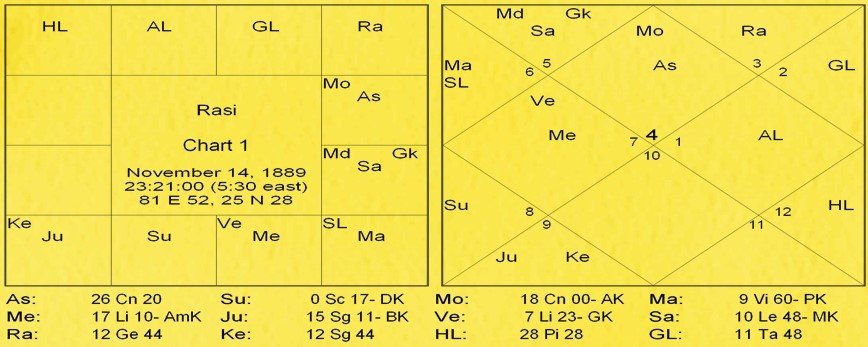
Take dasanatha Mars as lagna and apply the thesis. For Virgo (the abode of dasanatha), Mars is a functional malefic planet. However, its simultaneous ownership of kendra and kona from Cancer lagna makes Mars a prime benefic. Moreover, dispositorship of friendly Sun is rendering the Mars powerful. Now consider relative planetary positions. Trinal houses (5th-9th) from Mars (i.e. Capricorn and Taurus) are empty. Now weigh the 2nd and 4th houses. Mercury and Venus are residing in 2nd from dasanatha with ample strength. The 4th house (Sagittarius) is occupied by Jupiter with Ketu. These fortunate combinations, in 2nd and 4th houses from dasanatha Mars, ensure excellent fruits of dhana and sukha. Coming to the 3rd-6th axis, we find Sun in 3rd house that promises victory over enemies and rivals. Absence of malefic planets in trine and presence of benefic planets in 2nd-4th enabled Mars mahadasa to yield sustainable progress without any major setback.
Come to Rahu mahadasa of Pandit Nehru that started functioning from February 1955. This major period changed the unchallengeable status of Nehru realm, yet he won two general elections (1957 and 1962) during Rahu mahadasa and remained in prime minister’s office until his last breath. No doubt, sign-wise Rahu is considerably well placed in Gemini, having direct aspect of Jupiter. But just imagine success in two successive elections in Rahu dasa who is in 12th house, not only in rasi, but also in navamsa and dasamsa.
Analyzing the relative planetary positions from dasanatha Rahu, we come across interesting signatures. Counting from Rahu, benefic Moon is sitting in 2nd house, Venus with Mercury is enjoying the 5th kona, while both 3rd and 6th houses are occupied by malefic Saturn and Sun respectively. So there is all around planetary support. The only troublesome planet is Mars if reckon from dasanatha Rahu. In fact, it is Mars in 4th (from dasanatha Rahu) that produced increasing political opposition and decreasing public support. On international front, border dispute with China also brought forth (that is another matter caused by evil occupation of 4th house from dasanath). But, since the rest of the planets are favourable and robust with respect to Rahu, therefore he remained prime minister until his death in Rahu-Mercury-Mars.
Case-2: Nobel Prize
An extra ordinary genius, famed physicist and a real humanist – Albert Einstein – was born with planetary map, illustrated as case 2. Astrological books and blogs are filled with the praise of choicest combinations in his chart, especially in 9th and 10th houses, viz. the dharma-karma raja yoga between Jupiter and Saturn, Malavya yoga, Neech bhanga raja yoga etc. But his story of worldwide success is spanned from 1921 to 1955. These years cover three mahadasas: Moon, Mars and Rahu. Keep in mind that he neither saw maha dasa of Jupiter, nor of Saturn. Whereas Venus mahadasa (1895-1915) did not bestow any name, fame or money. He first tasted the raja yoga in the ill-placed Moon dasa. One may wonder how a travel of mundane achievements can begin from a dasa, who is debilitated in rashi, depression in navamsa, and occupied in 6th house without any aspect or association.
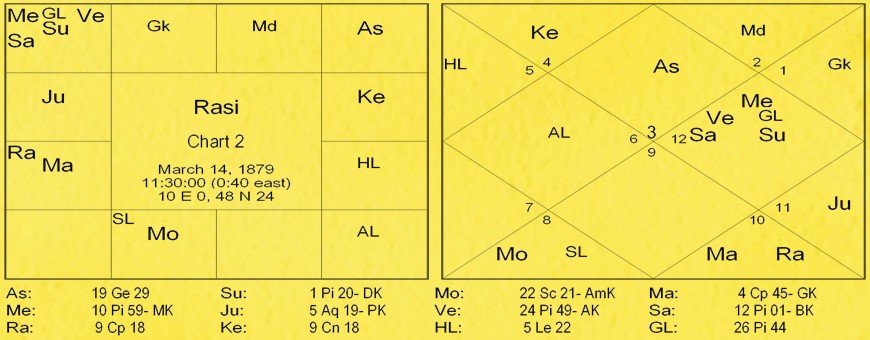
Although, he had presented his ‘relativity theory’ quite early, still until ripening of Moon major period, all of his efforts were confined to a limited circle of peer reviewers of scientific journals, contemporary physicists, and intellectual friends. It was only in Moon dasa that the world acknowledged him after receiving Nobel Prize in November 1922.
Let’s analyze Moon mahadasa in the light of relative planetary positions. First see the trinal houses (5th-9th) with respect to dasanatha Moon. A cluster of 4 planets are sitting in 5th house and fortunately no one is combust. Among pair of 2nd-4th houses, the 2nd house is vacant but 4th house is tenanted by benefic Jupiter. In fact, (counting from Moon dasa) lord of 5th Jupiter is making maha parivartana yoga with lord of 4th Saturn that confers obtainment of name and fame. Coming to pair of 3rd-6th houses, we find two deadly malefic planets (Mars and Rahu) in 3rd house from dasanatha Moon ensuring success and victory. Summing up discussed above factors, Moon appears really capable enough to impart the raja yoga phala. Since dasanatha Moon owns the 9th house from itself while assemblage four planets are in Pisces, the arena of success was intellectual rather material or political.
Well, judging Moon and its relative planetary placements does not at all entail that Moon’s location with respect to janma lagna (natal ascendant) doest not manifest. It does matter and it mattered for native as well. In fact, Albert Einstein encountered financial loss in Moon dasa, when he invested the amount accrued from the Nobel Prize in USA. But his investment drowned, since Moon as owner of 2nd house (from ascendant) sitting in 6th house in debilitated state.
Case-3: Financial and Professional Setback
Case-3 illustrates the chart of a medical doctor who left his practice and successfully espoused hotel and property business. During mahadasa of debilitated Sun, native flourished and earned lot of monetary benefit. But as soon as Moon’s mahadasa began, his entire business setup came to ground and he had to encounter huge financial lose and fraud. He could not yet recover the lost status and money, despite the existence of Moon’s neecha bhanga and her association with yoga karaka Venus in 11th house.

Consider the Dasanatha Moon as lagna and judge the relative planetary placement from it. Trine (5th-9th) from dasanatha is vacant. There is a malefic Ketu in 2nd whereas 4th is empty. Thus Moon is void of planetary factors that could support and sustain the finance (2nd house), comfort (4th house) and opportunities (5th and 9th houses). But the most evil signature is the occupation of Saturn and Rahu in 8th (from dasanatha) without any benefic association/aspect. Note that here in this case, Saturn and Rahu are adhi-shatru of Moon. Unfortunately, there is no benefic in 2nd or 11th (with respect to dasanatha Moon), nor any beneficial aspect over Saturn+Rahu that could counter the evils of 8th. Resultantly, professional setback, depletion of property and insurmountable financial loss occurred during Moon mahadasa. Moon-Rahu and Moon-Saturn specially proved worst. However, in between these two dreaded antardasas, Moon-Jupiter yielded some silver lining and partial obtainment of lost money since Jupiter owns 2nd and 5th houses and tenants in 10th from dasanatha.
Here a point should be kept in mind that Venus has identical planetary placement as Moon, but Venus dasa did not yield loss of finance, property or fraud. Since she has a nexus with Mars, i.e. there exists a rasi parivartana between Venus and Mars. It is already maintained (under heading of exceptions) that planets in parivartana often behave differently. Moreover, Saturn and Rahu (who are tenanting the 8th from Venus) are not that inimical towards Venus.
Case-4: Business Tycoon
The native of chart 4 is literally a business mogul as he owns chain of 5-star hotels, vast landed property, oil wells and gas fields in Pakistan. Exalted dhanesha (Venus) in 7th and labhesha (Moon) in 10th from ascendant made him billionaire. The very Venus – as lord of 2nd and 9th – in Kendra to Moon is another powerful dhana yoga. Debilitated Saturn, being lord of 6th in 8th with 8th lord, constitutes flawless Vipreet raja yoga. However, Goddess Laxmi knocked his door during Mercury dasa!!! Yes, in Mercury dasa who is sitting in 6th house with 12th lord Sun.
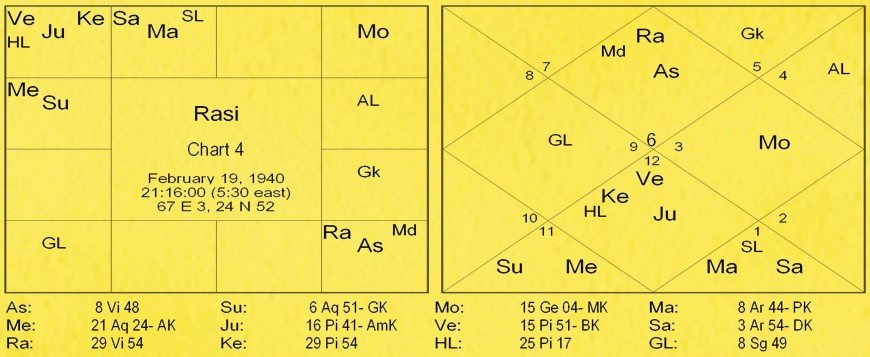
Let’s solve this riddle. Consider dasanatha (Mercury) as lagna. Moon is residing 5th whereas 9th is vacant. Coming to 2nd-4th, we find uccha Venus and swakshetra Jupiter with Ketu in 2nd house. Nodes in benefic signs with benefic planets behave akin to them. Fortunately, Venus is the lord of 4th and 9th while Jupiter is the lord of 2nd and 11th from dasanatha. Combination of Venus and Jupiter in 2nd (from Aquarius) forms excellent dhana yoga. Now come to 3rd-6th houses from dasanatha. Two dire malefic planets (Saturn and Mars) are relegated in 3rd house, enhancing the robustness of dasanatha. This signature entails success in new endeavors and victory over competitors. Interestingly Rahu in 8th from dasanatha is unable to pull down the native, as 2nd from dasanatha is more powerful than 8th (however native had conflict with government over tax evasion issue during Mercury-Rahu). But summing up all factors, entire Mercury mahadasa proved very beneficial for the native.
In contrast to the Mercury period, emergence of Venus mahadasa (from October 2005) unfolded many difficulties including destruction of immovable property, despite the fact that Venus is forming many desirable yogas. It may be argued here that Malavya Yoga (again formed by dasanatha Venus) is cancelled by association of Ketu. But it should not be forgotten that effect of Mahapurusha yoga (like Surya, Chandra, Nabasha etc.) does not depend upon ripening of involved planets’ period. So putting the question of Malavya yoga aside, let’s analyze Venus with respect to relative planetary positions.
Venus is in Pisces with its lord Jupiter. Ketu is also there, but it has crossed the nakshatra, occupied by Venus. Looking the 5th-9th houses from dasanatha Venus, no planet resides there. Now judge 2nd-4th houses for the sustenance and comfort. We find two evils (Saturn and Mars) in 2nd and a powerful Moon in 4th, leading to a mixed situation. Whereas another set of houses i.e. 3rd-6th (which is a supposed welcome abodes for malefics) is empty. Summing up these factors, it is a mixed-cum-malefic planetary map, setting around dasanatha Venus. Two malefics in 2nd house (in malefic sign) from dasanatha is indeed an unfortunate signature that indicates destruction of accumulated wealth and assets. During Venus-Venus, Marriot Hotel Islamabad (owned by him) was blown out by terrorists on September 20th, 2008. This deadly event in his hotel killed 54 innocents and injured some 266 people. Later, a wave of terrorism in the country and global financial crunch led to continuous decline in his hotel business (2nd Saturn in sign of Mars, is aspecting Moon as well as 4th house from dasanatha). During the very antardasa of Venus-Venus, another ill fated hotel, owned by the native, faced terrorist attack. He also encountered dispute with government over compensation and land issue. However, he got off and on profit through oil and gas fields.
Off course placement of Venus in Scorpio navamsa and Aries Dasamsa is also responsible for fire and destruction of property and downfall in wealth. These fundamentals cannot and should not be avoided. But relative planetary positions from dasanatha significantly explain the optimum potential of lord of period.
Case-5: Academic Distinction

This is a chart of female who has had distinguished academic career during Rahu mahadasa. Northern lunar node is placed alone in 4th house with Gulika and Mandi, and void of benefic association and aspect. Yet, it lent exceptionally beneficial results.
Consider Taurus (the sign where dasanatha Rahu resides) as lagna and analyze relative planetary positions. First take trine (5th-9th) houses. Venus and Moon are ensuring luck by sitting in Capricorn (9th from dasanatha). The 2nd-4th set of houses are empty but conjunction of two malefic planets (Mars and Saturn) in 6th from dasanatha is a promising signature of success in competition.
Association of Moon and Venus usually bestows aesthetic sense and bent of mind towards art and culture. With fine art and Urdu literature as optional subjects, she topped in graduation during antardasa of Rahu-Mercury. Now find the relation between mahadasanatha (Rahu) and antradasanatha (Mercury). From Taurus (the sign domiciled by Rahu), Mercury owns 2nd (Gemini) and 5th (Virgo). It is tenanted in 10th house with 4th lord Sun. Is it difficult to deduct the meaning of 4th+5th lords in 10th house during academic life, especially when they are simultaneously vidya karaka and ra
This is a chart of female who has had distinguished academic career during Rahu mahadasa. Northern lunar node is placed alone in 4th house with Gulika and Mandi, and void of benefic association and aspect. Yet, it lent exceptionally beneficial results.
Consider Taurus (the sign where dasanatha Rahu resides) as lagna and analyze relative planetary positions. First take trine (5th-9th) houses. Venus and Moon are ensuring luck by sitting in Capricorn (9th from dasanatha). The 2nd-4th set of houses are empty but conjunction of two malefic planets (Mars and Saturn) in 6th from dasanatha is a promising signature of success in competition.
Association of Moon and Venus usually bestows aesthetic sense and bent of mind towards art and culture. With fine art and Urdu literature as optional subjects, she topped in graduation during antardasa of Rahu-Mercury. Now find the relation between mahadasanatha (Rahu) and antradasanatha (Mercury). From Taurus (the sign domiciled by Rahu), Mercury owns 2nd (Gemini) and 5th (Virgo). It is tenanted in 10th house with 4th lord Sun. Is it difficult to deduct the meaning of 4th+5th lords in 10th house during academic life, especially when they are simultaneously vidya karaka and rajaya karaka?
Case-6: Incomplete Education
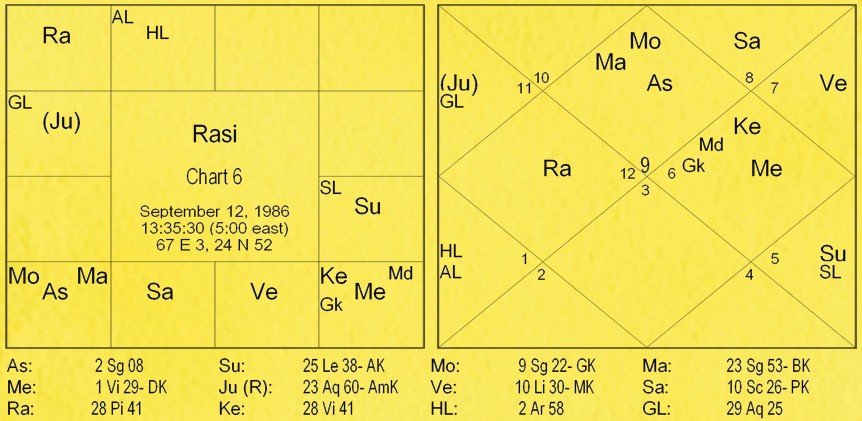
Case 6 illustrates a chart with a poor academic record and carelessness towards importance of education. His schooling began in sub period of Venus-Venus. But with the progress of Venus mahadasa, native showed difficulties in comprehension and at the end of Venus major period, he left the education without completion. Prima fascia, it is indigestible for a novice of jyotish to understand why a well disposed Venus denied scholastic obtainment, but yielded all other favourable significations in its period.
Having robust shadbala and vimsopakabala, Venus is placed in 11th house in mooltrikona rasi. Excluding education; native performed well in the rest of the all fields. He is dynamic, dexterous, beloved of kith and kin, and owned personal vehicle right from a very early age. But he is destitute of college and university education. Well, there exists a yoga for incomplete or ordinary education in this chart-6. It is said, when 2nd lord or Vidya karaka Mercury falls in the navamsa of Saturn (or a malefic planet) and 2nd house itself comes under sole influence of malefic planets, then native is unable to earn proper education. This yoga fulfills the condition both from natal ascendant and dasanatha.
No doubt benefic Jupiter in 5th house (from dasanatha) and malefic Mars in 3rd house are welcome signatures but Jupiter is the dispositor of Rahu. Yet, Jupiter in 5th from lord of dasa ensures intelligence and support (in fact, native is brought up in an educated family, and his elder siblings are known for their learning and knowledge). It is the Saturn (in Scorpio) next to Venus that desolates the educational prospects. Moreover, Saturn is directly aspecting the 4th house from dasanatha. So both 2nd and 4th houses are under evil influence of Saturn, leading to incomplete education. Ketu and Mercury in 12th to dasanatha Venus further abated the possibilities of uninterrupted academic career. Resultantly, after failing twice in intermediate (12th grade) during Venus-Saturn, native left the education for good. Later in Venus-Mercury, he joined a music school for learning guitar, but here again he could not attain the diploma certificate.
Case-7: Marriage & Birth of Son
Horoscope given as case 7 belongs to a female who married and begot a son during Venus antardasa in Mercury mahadasa. Her wedding took place on November 9, 2008 and first child born on December 25, 2009. Conventionally speaking, mahadasa lord Mercury owning 7th house and Venus as Vivah (marriage) and sukha karaka in 2nd from janma lagna gives a clue of family beginning. But let’s peep beyond the veil and read the antardasanatha Venus in the purview of relative planetary positions.
By sitting in Aries, Venus owns the 7th house from itself and conjoined with Mars. The 2nd and 7th houses are respectively tenanted by Jupiter and Moon. This signature reveals obtainment of happiness, wealth and strong probability of marriage. Parashara’s Hora Shastra suggests marriage festival and beginning of family for benefics in 2nd or 7th house. Besides, Sun along with Mercury in 3rd and Rahu in 6th are fortifying the potency of antardasanatha Venus. Nonetheless, Saturn in 4th from antardasanatha Venus curtails the warmness in domestic harmony. In fact, after marriage she cut off all contacts with kith and kin in Venus-Mercury. Note that 4th is a Bandhu sthana and stands for close friends and relatives.

Apart from the above analysis, the chart is also a typical example of love marriage that occurred bit late at age 32. But as soon as marriage took place, the affection between the couple turned into coldness. Here, aspect of Saturn on 7th house from lagna as well as on Venus+Mars explains the mirthless marital relation. However, aspect of Jupiter on 7th house, and the occupation of 7th lord Mercury in the amsa of Jupiter is a saving factor.
Case-8: Death of Brother
This is a chart of a lady who had an unexpected event during a yoga karaka period. On October 14, 1994, her brother died suddenly in the antardasa of Venus and mahadasa of Mercury. Seemingly it appears impossible, as neither Venus nor Mercury is functional malefic for Aquarius lagna. Moreover, Mercury and Venus as lord of 5th and 4th, abode in each other’s houses and constitute maha parivartana yoga.
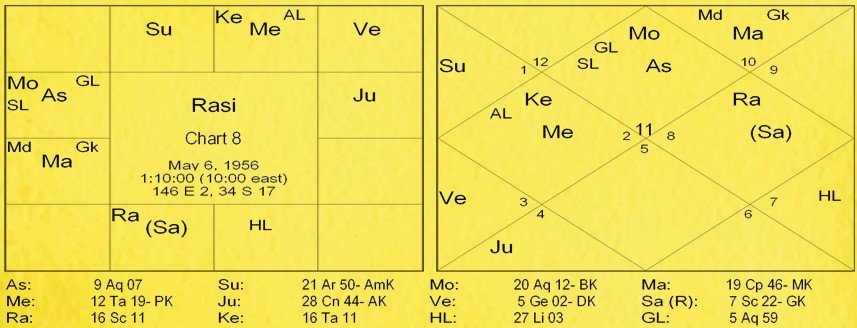
Taking antardasanatha Venus as ascendant, 3rd house (Leo) is severely annihilated by aspect of Saturn and Mars. Its lord Sun, although exalted in rasi but debilitated in navamsa is devoid of beneficial aspect. Furthermore Brathru Karaka Mars (in 8th from Venus) forms a parivartana with Saturn (who is in 6th from Venus). But rationally speaking, these astrological arguments are not capable enough to infer the destruction of brother.
In the section of exceptions, it is mentioned that in most of the cases, when dasanatha involved in parivartana, advanced thesis of relative planetary positions from dasanatha appears insignificant. Here too, the riddle of her brother’s death is more unequivocally solved by dispositorship criterion rather relative planetary positions. Sun is in 3rd house in the sign of Mars and solely aspected by Mars. Occupant of 3rd house, Sun, is in bharani nakshatra and Libra navamsa. And Venus – the antardasanatha – is the navamsa and nakshatra dispositor of Sun. Consequently, Venus antardasa yielded death of brother. The purpose of including this chart is to remind the readers that given thesis is not the sole or first parameter for judging a planetary period.
Case-9: Buying House
Saturn is considered a functional malefic planet for Pisces. But for the female native of chart, illustrated as case 9, the emergence of Saturn mahadasa from February 2009 brought many auspicious events. During the very first antardasa (Saturn-Saturn), her husband purchased a costly villa in a posh area, and there happened celebrations in the home.
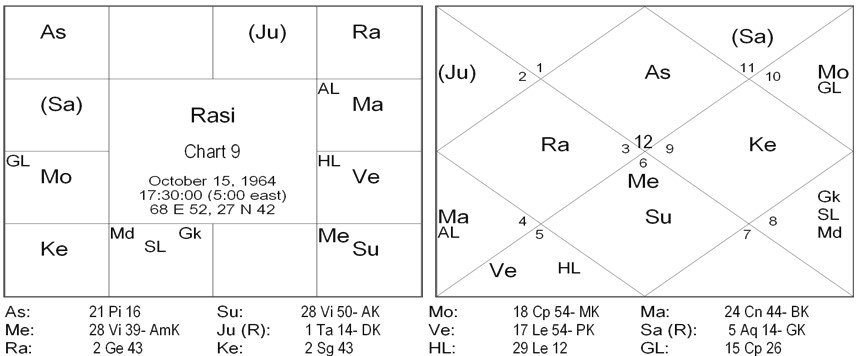
Saturn is a functional malefic with respect to Pisces lagna, but counting from the sign where dasanatha is placed, Saturn is sitting in Mooltrikona rasi Aquarius, and directly aspected by Venus. In other words, lord of lagna in lagna having sambandha with yoga karaka (Venus). Note also 2nd lord Jupiter from dasanatha Saturn, is placed in 4th house while 4th lord Venus is domiciled in 7th house and casts a full glance over Saturn. Resultantly, she along with her whole family settled into a luxurious home. But, Rahu in 5th house (from dasanatha Saturn) is not a welcome signature. Rahu usually deserts the person signified by the house it occupies. In fact, the native’s second son achieved commission in armed forces and left her for training. So Rahu did its result but in a positive way, since the dispositor Mercury is exalted with Sun in 8th from dasanatha.
Case-10: Professional Success
Born in a humble circumstance, the native rose to the rank of army general with his sheer efforts and slight wind of good luck. The chart belongs to Pakistan’s (present) Chief of Army Staff, General Ashfaq Kayani.
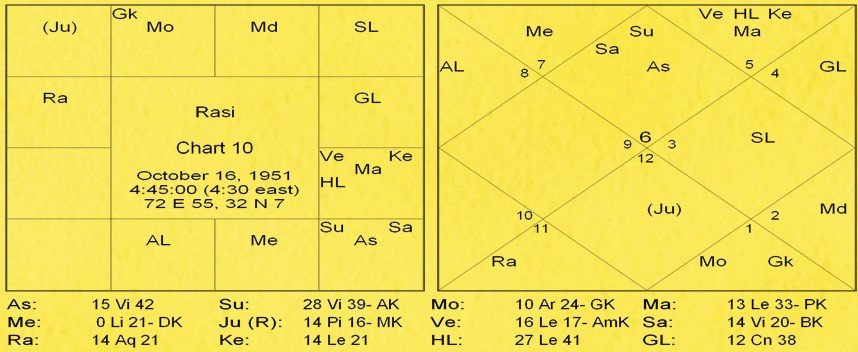
His story of professional success started in 1996 with the commencement of Rahu major period. Have a look at Rahu in the purview of relative planetary positions. First judge the trinal (5th-9th) houses from Rahu. The 9th house (Libra) is occupied by 5th lord Mercury. The 2nd house is powerfully tenanted by its own lord Jupiter and 4th house is free from malefic aspect and association. However, the set of houses formed by 3rd-6th is not desirably disposed by natural malefics. Similarly, Saturn with Sun in 8th house (from dasanatha) is again an impeding factor. Yet, auspicious placement of trinal houses and 2nd Jupiter render Rahu capable enough to confer raja yoga.
In fact, the Goddess of fortune once again smiled upon him during Rahu-Jupiter when he was promoted to the post of director general of military operations (DGMO) in December 2000. With respect to dasanatha Rahu, Jupiter is the lord of 2nd and 11th houses and beneficially placed in the 2nd house. The trinal houses (from antardasa lord Jupiter) are vacant, but 5th lord Moon is occupying the 2nd, which ensures gain of power.
His progress continued even in the antardasa of Rahu-Saturn and he became lieutenant general. Earlier, in case 3, it was argued that Saturn’s placement in 8th from dasanatha leads to destruction and suffering. Though Saturn is similarly placed in 8th house from dasanatha Rahu, here Saturn is the lord of dasanatha itself, having full aspect of Jupiter, and hemmed in between two natural benefic planets. So antardasa of Saturn did not resulted in professional set back, yet, he had to serve very difficult and painstaking operations during Saturn antar of Rahu mahadasa.
He was promoted to the rank of vice chief of army staff in October 2007 when concluding days of Ketu antar in Rahu mahadasa was running. But soon after during the next month, a surprising scenario took place in Islamabad’s corridors of power. In the mean time, his Venus antardasa had started. No one, even he himself, was expecting the post of Chief of Army Staff office just after one month of becoming vice-chief of army staff. But it was the ill fate of General Pervez Musharraf that he had to abdicate the office of military head as a result of increasing political and public pressure. Resultantly, the native (General Kayani) assumed the office of Chief of Army Staff on November 28, 2007 just after beginning of Rahu-Venus. For Virgo ascendant, Venus in 12th is not a chosen abode to sit in. But reckoning from the major period lord Rahu, Venus is the lord of 9th and Mars is the lord of 10th. Venus with Mars is forming a dharma-karma raja yoga with respect to dasanatha Rahu who is placed in Aquarius.
It should be borne in mind that effect of dasa or antardasa cannot surpass the efficacy of natal chart. Here in this nativity, a few unique raja yogas exist that catapulted him to such a dizzy height, viz. chara atmakaraka Sun is conjoined with 5th lord Saturn in lagna and out of navgrahas, 6 planets are vargottam.
Conclusion
This study is an innovative attempt (but based on the classical aphorisms) to unravel the puzzle of dasaphala (effects of planetary periods). Inferences obtained from above case studies, endorse the significance of relative planetary position with respect to lord of dasa/antar. Nonetheless, it is not a primary judgment parameter, although it is difficult to avoid this criterion. Studying the relative planetary position helps to forecast the dasaphala with more precision and greater certainty.
Learn Astrology: Join Our Upcoming Astrology Classes — Click Here
Learn Astrology: Join Our Recorded Astrology Classes — Click Here
 Saptarishis Astrology Magazine Into Creating Astrologers
Saptarishis Astrology Magazine Into Creating Astrologers






